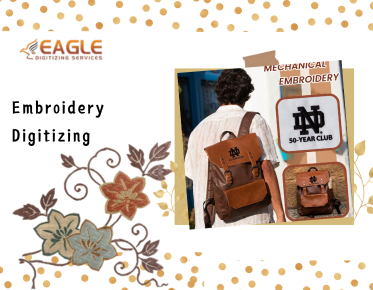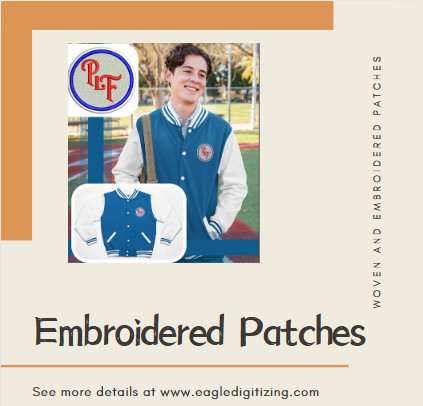Why Embroidery Settings in Digitization Matters
Embroidery is more than just a craft; it’s a delicate balance between art and precision, especially when it comes to machine embroidery. Behind every crisp design and vibrant logo, there lies a set of settings that dictate how a design comes to life on fabric. From thread tension to speed, these settings play an essential role in digitizing and ensuring that your final product is flawless. Whether you're a seasoned professional or a novice, understanding how to fine-tune these embroidery settings is the key to transforming digital designs into tangible, high-quality embroidery.
Understanding the Basics of Embroidery Settings
What
Are Embroidery Settings and Why Do They Matter?
Embroidery
settings are the adjustable parameters on your machine that influence how your
design is stitched onto fabric. They control everything from the thread's
tension to the machine's speed, and even how the needle moves across the
fabric. These settings are crucial because they ensure that the machine
stitches accurately, the design appears crisp, and the thread lays smoothly on
the fabric. Even the most intricate designs can result in uneven stitches,
puckered fabric, or broken threads without the right adjustments.
The
Importance of Fine-Tuning Settings for Quality Embroidery
The beauty of
embroidery lies in the details, and to achieve that level of precision, you
need to fine-tune every setting. For example, adjusting stitch density or
length can drastically alter the texture and appearance of the design. A
setting that works perfectly for one fabric might distort another. This makes
it essential to test and tweak the settings until the desired outcome is
achieved, ensuring that every stitch enhances the design.
How
Settings Influence the Final Appearance of Your Design
From the texture
of satin stitches to the boldness of running stitches, each setting influences
how a design appears once it's stitched. Too much tension and your stitches
could become too tight, distorting the fabric; too little, and the threads may
loosen, causing gaps. In essence, the settings are the unsung heroes of
embroidery—they ensure your design maintains its integrity, stays sharp, and
holds up over time.
Key Embroidery Settings That Affect Digitization
Stitch
Length and Its Impact on Texture
Stitch length is
one of the most fundamental settings in embroidery.
Longer stitches create a smooth, flowing look, perfect for larger fills or
simple outlines. On the other hand, shorter stitches are better for finer
details, offering precision but often adding texture. Adjusting the stitch
length allows you to control the texture of the design, whether you want it to
appear soft and smooth or dense and bold. It’s the thread's "rhythm,"
setting the tone for the entire design.
Adjusting
Stitch Density for Different Fabrics
The density ofthe stitches directly impacts how well a design will hold up on different
fabrics. High-density settings are ideal for firm fabrics like canvas, while
lower densities work better for lighter fabrics like cotton. Too high a density
on a light fabric can cause the material to bunch up or distort, while too
little density on a heavier fabric may leave the design looking sparse. Finding
the right balance is crucial to ensuring that the design is well-executed and
remains durable across various types of fabric.
The
Role of Stitch Width in Achieving Crisp Designs
Stitch width, particularly in satin stitching, plays a pivotal role in creating a sharp, clean outline. A wider stitch is often used for bold, defined edges, while a narrower stitch is better for fine lines and delicate detailing. Adjusting the stitch width allows you to control the boldness of your design, whether you want something striking and visible or subtle and intricate.
Tension Settings: Balancing Thread and Fabric
How
Thread Tension Affects Stitch Quality
Thread tension is
perhaps one of the trickiest settings to master in embroidery. If the tension
is too tight, the stitches may pull the fabric, creating puckering and
distortion. On the flip side, if the tension is too loose, the stitches may
become too relaxed, leading to skipped stitches or a loose, unrefined
appearance. Proper tension ensures that the thread sits perfectly on the
fabric, providing a neat and uniform stitch.
Troubleshooting
Tension Issues for Flawless Designs
Tension issues
often arise when switching between different fabrics or thread types. If you're
encountering puckering or loose stitches, adjusting the tension slightly can
help. It’s essential to experiment with your machine’s settings and test
stitch-out to find the right balance. If tension problems persist, it may be
due to faulty bobbins or incorrectly loaded thread, so always double-check your
setup.
Setting
Tension for Different Fabric Types
Not all fabrics
react the same way to thread tension. For example, a delicate silk fabric
requires a lighter tension to avoid damaging the fibers, whereas sturdier
materials like denim or leather can handle a bit more tension without
distortion. Understanding the unique characteristics of the fabric you're
working with will help you adjust the tension settings accordingly for a
flawless stitch.
Speed and Its Effect on Embroidery Precision
How
Machine Speed Impacts Stitch Accuracy
Speed is another
crucial factor in embroidery, especially when it comes to intricate designs.
While faster speeds may seem efficient, they can compromise stitch accuracy,
leading to irregular stitches or misalignment. Slowing down the machine can
give the embroidery more precision, allowing for more detailed and accurate
stitching, particularly on fine or complex designs.
Adjusting
Speed for Complex and Simple Designs
For simpler
designs with fewer color changes, higher speeds might be suitable. However, for
more intricate designs or those with lots of detail, reducing the speed can
allow the machine to focus on accuracy rather than speed. Complex designs often
require a slower speed to achieve the sharpness and clarity that make the
design pop.
Finding
the Right Speed for Different Thread Types
The type of
thread you're using also affects the ideal machine speed. Delicate threads,
like metallic or silk, often require slower stitching speeds to prevent fraying
or breakage, whereas standard threads like polyester or cotton can handle
faster speeds without compromising the quality of the stitch.
Needle Size and Type: The Unsung Heroes of Embroidery Settings
Matching
Needle Size to Thread and Fabric
The needle size
plays a vital role in embroidery quality. A needle that’s too large for the
thread may cause uneven stitches, while a needle that’s too small can lead to
thread breaks. It’s important to match the needle size to both the fabric and
thread you’re using. For fine threads and delicate fabrics, smaller needles are
ideal, while heavier threads and thick fabrics require a larger needle to
accommodate the thread thickness and ensure smooth stitching.
Why
Needle Type Matters for Specific Designs
Different needle
types are designed for specific fabrics or designs. Ballpoint needles are great
for knits and stretchy fabrics, as they don’t cause snags, while sharp needles
are ideal for woven fabrics like cotton or denim, ensuring clean punctures
without fabric damage. Choosing the correct needle type ensures that your
machine can work with the design smoothly, enhancing the overall quality of the
embroidery.
How
Needle Choice Affects the Durability of Stitches
The right needle
choice also impacts the durability of the stitches. A blunt or worn-out needle
can cause thread breakage, uneven stitches, or excessive wear on the fabric.
Regular needle changes and using the right type for each design or fabric can
drastically increase the longevity of your stitches, preventing costly repairs
and rework.
Hooping and Stabilization Settings
Proper
Hooping for Consistency and Precision
Hooping is
crucial for ensuring that the fabric remains taut and aligned during stitching.
If the fabric isn’t properly hooped, the stitches can become misaligned or
distorted, leading to uneven designs. Proper hooping keeps the fabric in place,
ensuring the design stitches in the correct location every time.
Choosing
the Right Stabilizer for Different Fabrics
Stabilizers are
essential for providing the necessary support for the fabric while being
embroidered. For lightweight fabrics like tulle or organza, a lightweight
stabilizer is required to avoid adding excess bulk, while heavier fabrics like
fleece need a more robust stabilizer. The right stabilizer ensures that the
fabric doesn't shift or stretch during stitching, maintaining the integrity of
the design.
How
Stabilization Impacts the Quality of Your Embroidery
Stabilizers are
the backbone of a clean and professional-looking embroiderydesign. Without the proper stabilization, fabrics can shift or stretch,
causing misalignment or distortion in the final product. It’s important to
choose the right type and weight of stabilizer for the fabric to ensure that
the design retains its quality and stays neat, sharp, and true to the digital
file.
Thread Selection and Color Settings
Choosing
the Right Thread for the Job
Selecting the
correct thread is fundamental to the success of any embroidery project.
Different types of threads, such as polyester, rayon, or cotton, behave
differently when stitched onto fabric. Polyester, for example, is known for its
durability and vibrant color retention, making it an ideal choice for designs
exposed to wear and tear. Rayon, on the other hand, gives a soft sheen that’s
perfect for logos or designs that require a luxurious finish. Understanding the
characteristics of each thread type allows you to select the one that best
suits the design and fabric, ensuring a high-quality final product.
How
Color Settings Affect Thread Coverage and Effectiveness
Color settings
play a pivotal role in achieving the correct coverage and appearance. By adjusting
color settings in your embroidery software, you can ensure that each color
block appears crisp and true to the original design. For example, certain
threads may appear dull under certain lighting conditions, so adjusting the
color settings ensures that the final product matches the intended look.
Additionally, the right color contrast will prevent stitches from blending into
the fabric, helping the design stand out and achieve the desired impact.
Matching
Thread to Fabric for a Seamless Design
The thread’s
finish and texture should align with the fabric to create a harmonious design.
A glossy thread, for instance, may look fantastic on smooth, shiny fabrics like
satin, while matte threads are better suited for textured materials like denim
or canvas. Additionally, thread color should be chosen based on the fabric’s
color and texture to maintain visual balance. Paying attention to these details
ensures that the design looks seamless, with the thread blending naturally into
the fabric rather than clashing or standing out in a jarring way.
Mastering embroidery settings is not an overnight process, but the rewards are well worth the effort. By understanding the role that each setting plays in the overall design, you can tailor your machine’s performance to create clean, professional results every time. Whether you’re working with delicate threads, complex designs, or simple logos, the key is to experiment, test, and fine-tune each setting to suit your specific needs. With the right settings in place, your embroidery work will not only look great but stand the test of time, ensuring that every stitch is perfect and every design is executed with precision.


.png)
